Resources Biocompost Experiment: Teluk Intan, Perak
- Published in
- Category: Specialist Articles
- Hits: 5454




Why is soil pH important?
Soil pH plays an important role in determining the availability of nutrients to a plant.
At a pH < 6.0, the phosphorous present in the soil is 'fixed' and not available to the plant.
At a pH < 4.5, heavy metal and aluminium toxicity can occur, resulting in stunted growth.
At a pH > 7.5, the availability of micro nutrients and essential minerals such as Zinc, Copper,
Boron and Molybdenum are severely limited.
|
|
| Soil displaying optimum pH levels sustain healthy crops and produce rich yield. |
Optimum soil pH
Apart from plants which thrive in highly acidic soil, the optimum soil pH for the majority of plants is between 6.0 and 6.5. Soil featuring these pH levels are particularly conducive to nutrient uptake; fertilizers applied to soil displaying these pH levels demonstrate the best improved results.
In tropical conditions, most of the soil present display acidic properties. As such, monitoring and ensuring that the soil pH is kept at the optimum level is essential for healthy growth, good yield and promotes land sustainability.
Optimum soil pH chart
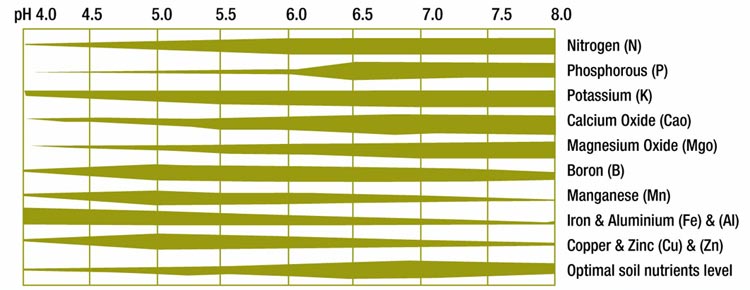 |
From Conventional Farming to Organic Farming
From Mineral Fertilizers to Compost
The system of intensive agriculture uses large amount of mineral fertilizers to stimulate and encourage plant growth and pesticides which could damage the balance of microbiological processes and fertility of soil. The evolution of agriculture in the last 2 decades had contributed to substantial lost of unrecoverable energy. The total agriculture production assisted by mineral fertilization today is estimated to lose 60% of unrecoverable energy as compared to organic fertilization. The decrease of organic matter in conventional intensive agriculture practice can be compensated by addition of organic matter as plant residues ploughing back into soil, alternatively, plant residue can be applied on the surface of soil in the form of mulch, green manure or composts.
The increasing demand for food is one of the most important issue faced by developing countries, particularly in the Tropics due to the recent rapid population increase in these countries. Direct application of plant residues, e.g., direct application of mulch on soil as nitrogen can result initially in nitrogen deficiency, phytotoxicity and low-yield. These problems can be avoided when plant residues are inoculated both with active decomposting cellulose and nitrogen generating microorganisms but the most efficient way is by application of well matured composts.
The sustainable development of environment and society is closely related to the natural recycling of materials through composting, thus decreasing chemical input and increasing soil organic matter content and fertility. Composting is the process of aerobic and anaerobic degradation of organic waste principally of plant origin, which may be agricultural waste, garden waste or domestic refuse. Good quality compost should be hygienic, highly humified, odourless and smell like fertile soil. Good quality compost should have suppressive effect on development of soil born pathogens, improve soil fertility, plant nutrition and plant yield.
WHAT IS COMPOSTING?
There are many definitions for composting and one of the more commonly used is: Composting is the biological conversion of organic waste under controlled conditions into a hygienic, humus-rich, relatively bio-stable product that improves land and plant nutrition uptake. So composting is both recycling and a waste management technology. Therefore the process and the product require many objectives to be achieved together.
The following can be defined as the main objectives of composting:
1. cost and/or economic reasons
2. environment conservation;
3. public acceptance;
4. controlling compost ecosystem:
(i) aerobic degradation in thermophilic (>55oC) and mesophilic conditions,
(ii) anaerobic degradation (>60oC); and
(iii) composting as a model for organic matter transformation in soil;
5. high quality composts: (i) high maturity; (ii) high stability; (iii) to improve soil fertility and to reduce soil and air contamination;(iv) to improve food quality thus to protect the health of human beings; (v) odour: prevention, removal or both; (vi) suitability for bio-remediation of heavy metal contaminated soils and improving soil microbial diversity; (vii) to produce energy for heating systems and electricity; (viii) composts used as growing medium; (ix) to contribute to the sustainable agriculture, environment and society.
6. Marketing and sales of composts
HOW TO SELECT GOOD COMPOST
The present agricultural and environmental situation in Malaysia requires farmers who wish to convert their traditional farming systems to organic farming to apply high quality composts in order to avoid any inconveniences and to increase their yield and make it sustainable agriculture practice.
Production of good quality compost should meet the following requirements :
- sufficiently long thermophilic stage (at least 10 days at temperature over 55oC; in fact, the thermophilic stage is recommended to be at between 60oC–70oC for 1 month) during which all pathogens and weeds seeds are completely destroyed,
- application of inoculants for composting processes acceleration, humification and suppression effect to development of soil born pathogens
- sufficient duration of the entire composting process (composting process less than 2 months will result in low stability and not well matured composts)
- good aeration (O2 content permanently over 12% in all stages) and mixing of compost during the composting process
- presence of control quality system which encompasses the following areas :
o quality of raw materials used,
o oxygen level,
o moisture level,
o pH level,
o nutrient amount and composition,
o electrical conductivity,
o encourage germination of seeds,
o stimulation of plant growth, and
o stability and maturity of composts
Amount of heavy metals in composts is also important for the health of buyers. For example, composts from most animal wastes are rich in heavy metals. Cow and horse excrements have acceptable amount of heavy metals, however, pig and chicken excrements have exceedingly high level of zinc and copper. Composts from chicken dung have in the beginning stimulating effect on plant growth, but after several applications, soil became too concentrated with zinc and copper, and exceeded the permissible standards, and thus inhibit development and growth of friendly microbial.
Also buyers are strongly advised to inspect the label and check content of nitrate nitrogen is higher than ammonium nitrogen, amount of NPK and micronutrients, availability of humic and fulvic acids.
Fully Matured Composts have the following characteristics :
WHAT IS THE DIFFERENCE BETWEEN BIG-SCALE & SMALL-SCALE COMPOST PRODUCERS?
Usually small-scale compost producers do not have sufficient and standard guidelines for quality control system; do not apply inoculants and the compost products have varying quality and quantity. Small-scale producers also have a tendency to produce compost with strong smell of ammonia or rotten cabbages. Big-scale producers are in a better position to guarantee quality control system, ensuring sufficient thermophilic stage, application of inoculants and their composts are fully matured as characterised by being odourless or earthly smell compost products. Their production quantity and quality is consistent, usually raw materials of mostly plant based origin are used.
DISADVANTAGES OF LONG TERM APPLICATION OF MINERAL FERTILIZERS ONLY
The application of mineral fertilizers as only one source of nutrients have the following main disadvantages: a/ significant reducing of biomass of root system (30-40%). This resulted in decrease of take up of soil nitrogen from plants as compare to nitrogen from mineral fertilizers; b/ significantly inhibit soil and root nitrogen fixation from air which in tropical condition is 70-90 kg N/ha/year; c/ there are shortages of molybdenum in the nitrate reductase enzymes in plant leaves which make nitrate nitrogen assimilable to plants; d/ acidify soils; e/ increase availability of exchangeable (toxic) aluminium in soils; f/ create conditions to appeared limitation of plant growth due to shortages of supply of micro nutrients; g/ resulted in nitrate contamination of yield of vegetables, fruits and grasses.
WHAT CAN A GOOD COMPOST DO & THE BENEFITS OF USING COMPOST
The most important criteria for good quality compost is high content of humic and fulvic acids. It is important to note several significant advantages of high humus composts: regulate and stimulate plant growth, increase yield to between 10-50% and quality of plant production; increase effectiveness of mineral fertilizers; stimulate clay-humus complexes and conserved nutrients; increase total amount of nutrients in soil, maximize capacity and turnover rate of nutrients in soils and maximize uptake of minerals from soil by plants; increase aeration and increase crumbly/friable/light of soils; increase tolerance of plant to draught; accelerate decomposition of plant residues; improve water infiltration and oxygen diffusion; increase water holding capacity, total prevention of nitrate contamination of fruits, minimise workers exposure to harmful chemicals and recover root to overground plant biomass ratio back to normal.
Our experience confirmed that compost rich in humic and fulvic acids will increase size and sweetness of dragon fruits, increase blossoming of plants and fruits stay fresh longer. Correct compost application method, and rate & amount, will increase yield to between 12-19%. A recommendation of 10 kg compost 2 times per year/Palm Oil Tree will give desired results. All trees, grasses, vegetables and flowers showed improvement in their vegetative development after being treated with compost.
CONCLUSION
Conventional intensive agriculture can be made more cost effective with the application of compost on top of regular mineral fertilizers application program. The cost effectiveness comes from higher efficiency of mineral fertilizer uptake by plants, stimulation of plant growth by humus in good quality compost and prevent loss of nutrients from soil. Yield increase of 12-19% for the Palm Oil Plantations have been observed. The increase of soil fertility level will make yield consistent and programmable for the next years.
See results of experiment for biocompost and mineral fertilizers comparisons in Ayer Tawar and Teluk Intan, Perak, Malaysia
by Ognyan Kostov and Ngan Teng Ye
Note: The excerpted information below was introduced at the Conference for Soil and Crop Quality Strategy 2006 in Kuantan, Malaysia
Increasingly, there is an emerging trend in a variety of Dragon Fruit Rotting Diseases found on dragon fruit farms in Malaysia. The symptoms include cessation of blossoming activities and vegetative growth halting. The diseases have been found to be caused by pathogenic microorganisms such as Fusarium oxysporum, Erwinia sp. and Aspergillus sp.
It has been hypothesized that these diseases have emerged due to the lack of healthy soil conditions caused by insufficient organic matter in the soil structure. Poor soil conditions have been caused by low soil pH, overuse of chemical fertilizers rich in nitrogen, and the use of low quality (unstable) composts made from animal by-products such as chicken dung that have not been properly sanitized and matured.
Treatment Promising ways to treat and recover plant health and yield, and prevent further attacks, include treating the plant and soil with carefully selected microorganisms that compete with the pathogenic microbes for nutrients and create antagonistic bio-chemical compounds.
This was done through a combination of applications:
1) By applying specially inoculated composts to the soil to balance the nutrient requirements of the dragon fruit plant
2) Treating the plant with a liquid microbial control agent which has a wide range of antagonistic effects against the pathogens
Results Recovery in one month with increased flowering compared to pre-treated plants
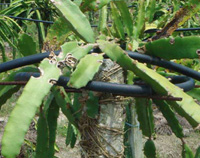 |
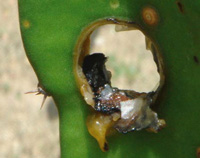 |
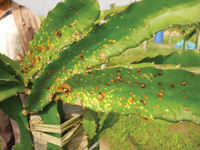 |
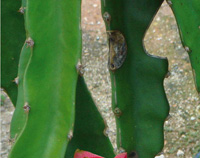 |
| 1) Pitaya plants under siege | 2) Close-up of diseased plant - rotting | 3) Close-up of diseased plant | 4) Plant recovers |
5 weeks since treatment began